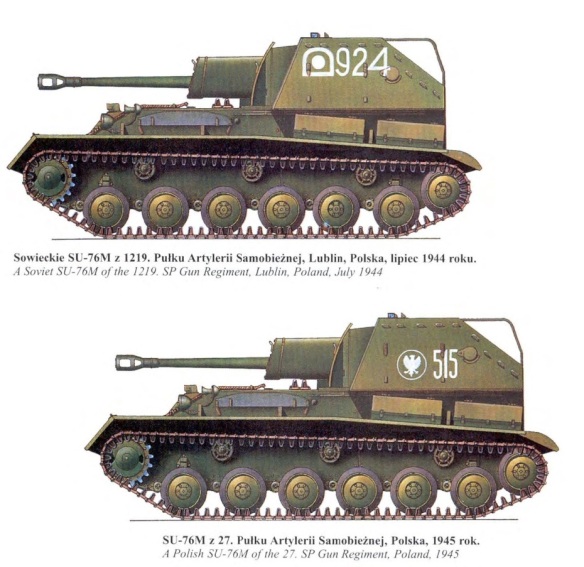All major armies also developed tracked or self-propelled guns, while the Wehrmacht and Red Army developed closely related assault guns and attendant doctrine. British and American armies used self-propelled guns in a similar manner, essentially as more highly mobile field artillery that advanced before concentrating in batteries to provide indirect fire support. This differed from German and Soviet practice, wherein self-propelled or assault guns provided close direct fire to support assaulting infantry. The exceptional industrial capacity of the United States permitted the U. S. Army, and most other Western Allied armies, to move toward fully motorized and mechanized artillery. The U. S. Army thus soon caught up in mobility to the British Army, and then surpassed it in terms of overall mobility. The main change in artillery in World War II was this fresh mobility
SELF-PROPELLED GUNS
A subclassification of artillery in which field guns were mounted on tracked carriages, usually the chaises of tanks. For instance, the British Sexton mounted a 25-pounder gun on a Canadian-built “Sherman” chassis. Almost all other Western self-propelled guns were of American design and manufacture but followed the same principle. An exception was that a 75 mm howitzer was mounted on some half-track chassis An early standard, U. S. Army selfpropelled gun was the M8. It mounted a 105 mm howitzer on an M3 “Grant” tank chassis. The British called the M8 the “Priest.” Later models mounted a 155 mm M1918 gun on the M3 chassis to form the M12, and a 155 mm mounted on an M4 “Sherman” chassis to create the M40. The M4 chassis could also mount an 8-inch howitzer and called the M43. A handful of even bigger guns were mounted on a “Pershing” chassis and classed as T92 and T93 self-propelled guns. The main German guns were the “Sturmgeschütz” (or Stug) III and Stug IV. The 105 mm “Wespe” and 150 mm “Hummel” were self-propelled howitzers. Later in the war the Wehrmacht built heavier assault guns by mounting large field guns on Panzer Mk III, Mk IV, and even some “Tiger” chaises. The Soviets and Germans differed in using tracked self-propelled guns mainly for direct fire in a close infantry support role where advancing infantry outran fixed artillery support, or where pieces towed by horse or wheeled vehicle could not go. Western armies tended to treat self-propelled guns simply as more mobile field artillery, combining them in batteries for indirect fire support.
ASSAULT GUNS
A subclassification of artillery referring to howitzers or other field guns mounted on tracked carriages, usually of surplus or outmoded tanks. They moved and fired in close support of attacking infantry. Although sharing the outer appearance of tanks they usually lacked turrets and sacrificed armor for speed and weight of gun. The main German assault gun was the Stug III (Sturmgeschütz III). It was equipped with a low-velocity 75 mm howitzer. From 1942 that gun was re placed by a high-velocity tube as Stugs took on Soviet or Western Allied tanks more often than they supported German infantry assaults. The Wehrmacht deployed increasing numbers of assault guns (“Sturmartillerie”) as the war continued, often in place of Panzers, which took far more steel, labor, and funds to build. Over time, production considerations meant that units supposed to be equipped with Panzers were instead given assault guns. These served primarily in an anti-tank role as the Wehrmacht moved to permanent defense in 1944-1945. The Stug III was built in large numbers as Panzer Mk III chaises were released with battlefield obsolescence of that model tank. The Stug IV was an upgunned, turretless, wider-tracked vehicle than the Stug III. Very late war German assault guns included squat urban fighting vehicles such as the Brummbär (“Grizzly”) and Sturmtiger (“Storm Tiger”). Their appearance was part of a general trend in design toward gigantism that ill-served actual combat needs, but it also reflected recognition that fighting in the east had shifted into big cities, away from the “happy days” of broken-field running by the fast Panzers of 1941-1943. Not many of the new urban warfare-type assault guns left German factories, fewer than 300 Brummbär and just a few dozen Sturmtiger. Early model Soviet assault guns such as the KV-2, which mounted a howitzer on a KV-1 heavy tank chassis, were easily knocked out during BARBAROSSA in 1941 and again in 1942. By the end of the war, however, the Red Army adapted and deployed a range of powerful and effective assault guns that served in a “tank destroyer” role; that is, as anti-tank guns. The Soviets mass produced the SU-class assault gun calibers of 76 mm and 122 mm and deployed huge SU-152 mm and ISU-152 mm guns. The SU-152 was called “zverboi” (“beast-killer”) by Red Army krasnoarmeets because of its success in destroying Tigers, Panthers, Elephants, and other German fighting vehicles with feral or animal names. British, Common wealth, and U. S. armies did not deploy assault guns as such, relying instead on heavy artillery, air power, and an abundance of tanks. The Western Allies modified some battle tank chaises-including the Sherman, Centaur, and Churchill-in the direction of what the Wehrmacht and Red Army called assault guns, replacing the main high-velocity gun with a howitzer. But Western armies used these primarily in an anti-tank role rather than for close infantry support. Americans termed such armored vehicles “tank destroyers,” not assault guns. On the whole, they did not perform as well as hoped by designers or in early U. S. Army doctrine.
